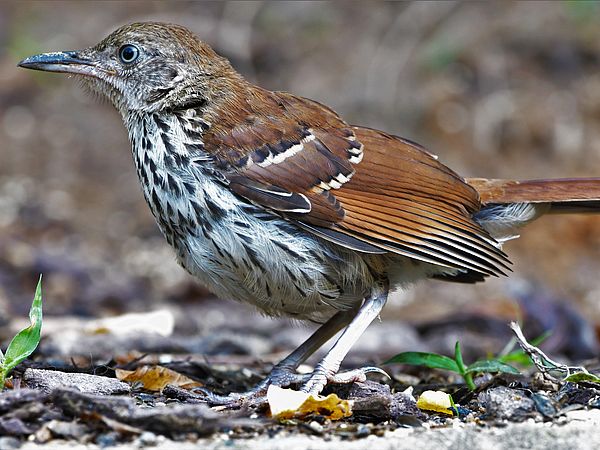Brown Thrasher – Secretive Songbird of Many Tunes
Article by Ava Steenstrup
Brown Thrashers are a beautiful bird species native to North America. They have warm rufous-brown plumage above, piercing amber eyes, two black and white wing-bars, whitish to buff underparts with dark brown streaks on the breast and belly, and a long, slightly down-curved bill. Both male and female birds are similar in appearance.
The Brown Thrasher resides in various habitats. It prefers to live in woodland edges, thickets, dense brush, and overgrown fields often searching for food in dry leaves on the ground. It can also inhabit agricultural areas and near suburban areas, but is less likely to live near housing than other bird species.
Brown Thrashers are mimics and are renowned for their impressive singing ability. They have one of the largest song repertoires of any North American bird with over 1,100 song types. In spring, a male will often be seen high up on a conspicuous perch singing a series of musical phrases, repeating each phrase twice before going on to the next one, to attract a mate. Males also sing to communicate territorial boundaries and to deter potential intruders without physical confrontation.
Although Brown Thrashers are known for their vocal prowess, they prefer to stay mostly out of sight, often hidden within thick undergrowth. Their earthy toned feathers help them blend seamlessly into their surroundings.
Brown Thrashers are omnivores. Their diet includes insects, berries, nuts, buds, and seeds, as well as earthworms, snails, and sometimes lizards, salamanders, small or young snakes, and frogs. Brown Thrashers forage for food on the ground, stalking and hopping about, using its bill to sweep the soil and leaf litter, with quick side-to-side movements. They also perch in shrubs or trees to eat berries such as wild grapes, holly, sumac, and elderberry.
The Brown Thrasher plays a vital role in the ecosystem. It helps control insect populations by consuming a wide variety of insects, including beetles, ants, grasshoppers, and caterpillars. By feeding on these pests, their diet indirectly benefits farmers and gardeners by reducing the need for chemical pesticides. In addition, this bird aids in the dispersal of various plant species through its droppings.
Brown Thrashers are monogamous and the male and female work together to build a cup-shaped nest of twigs, dead leaves, and grass, usually in low bushes, dense shrubs or low trees that often have thorns, and occasionally on the ground. The female will lay two to six eggs per clutch. Both the male and female help incubate the eggs and feed the young. The young leave the nest fully feathered within nine to twelve days of hatching. Pairs may raise a second brood in a nesting season.
Did you know? Brown Thrashers are usually inconspicuous, however, can be aggressive particularly when defending their nest and young. They will sing, flap their wings, and ultimately attack predators and intruders, including humans, to chase them away. They have been known to strike people and dogs occasionally hard enough to draw blood.

